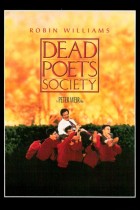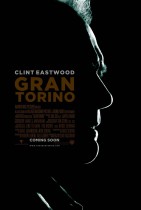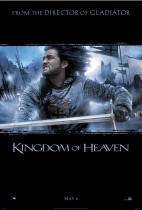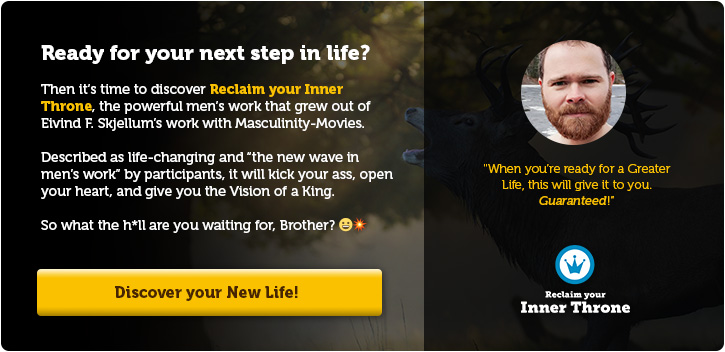The Ghost and the Darkness (1996)
Synopsis
The Ghost and the Darkness is based on a true story about two rogue, male, man-eating lions that took a devastating toll on the workers building a railroad bridge in British East Africa. It is the story of the man assigned with the responsibility of building the bridge and the man who helps him face the challenge of the lions.
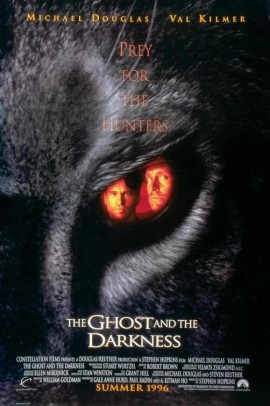
| Genre | Drama |
| Production year | 1996 |
| Director | Stephen Hopkins |
| Male actors | Val Kilmer, Michael Douglas, Tom Wilkinson |
Initiation and Mentoring
by Tom Crockett
The most profound developmental experiences and relationships in the life of a man are his initiations and his mentors. His initiations carry him over the threshold into a new world of possibility and responsibility. His mentors literally bring out the best in him. In urban contemporary society we have eliminated most forms of masculine initiation. Some professions such as the military still value the role of initiation, but by and large boys are left to initiate themselves through risk-taking and violent behavior. The problem is that boys can’t initiate other boys. For that you need a mentor.
In films the role of initiation and mentoring is still an important element. Many films portray initiation as a kind of clumsy and obvious process of a boy becoming a man. The 1996 film “The Ghost and the Darkness,” takes a more sophisticated approach. It shows us not an immature boy needing to become a man, but a self-assured and confident man who is capable and good at what he does who is presented with a challenge unlike anything he has had face before. The film reminds us that initiation is not a one-time affair, but something we will experience again and again as we grow and evolve from one level to the next.
The story, set in 1898 in British East Africa, begins with Col. John Henry Patterson (played by Val Kilmer) being hired to build a critical railroad bridge at Tsavo. Patterson is capable and confident. He is a good engineer, a clever and inventive thinker, a good manager and a decent man. What he faces shortly after arriving at Tsavo are a pair of man-eating, male lions who are hunting and killing the workers constructing the bridge. He tries to solve the lion problem with all the skills he has, but he is faced with something beyond his level of skill.
Enter the Mentor
Actually there are two mentors in this film. There is a shadow mentor in the form of the wealthy railroad owner who hires him to build the bridge, Robert Beaumont (played by Tom Wilkinson). Beaumont is a bully with a massive ego, but he does bring the initiation to Patterson and when Patterson is unable to deal with the lion problem because he is at the edge of his current level of skills, it is Beaumont who summons a real mentor for Patterson in the form of Charles Remington (played by Michael Douglas).
Remington is an older man and veteran hunter. He mentors Patterson in a number of ways, but three specific moments in the film stand out. If one wanted to learn how to mentor younger men, the lessons that Remington brings would be highly useful.
The First Lesson
Remington first appears when Patterson’s ability to keep order and confidence among his workers is breaking down. He has tried reason and negotiation, but, in this setting of fear run rampant (the workers have come to believe the lions are supernatural beings or demons), reason is not enough. Remington wades into the conflict and puts a gun to the head of the leader among the workers who is threatening Patterson.
He knows that in the world of real leadership, where lives are on the line, that sometimes fear can only be overcome by embodying a greater form of fear. He is willing to become that greater form of fear for the workers. His steely confidence and nerve, his willingness to kill, and his unpredictability become a more immediate and galvanizing source of fear among the workers. When the lead worker tries to tell him about the men’s fear of the lions by saying that the devil has come to Tsavo, he agrees: “You’re right. The Devil has come. Look at me. I am the Devil.”
And then, the moment after the lead worker backs down, Remington breaks the tension himself by extending his hand. He is willing to do what is necessary to resolve the situation, but he is also sensitive enough to know when, for the moment, the tension has shifted. He models for Patterson a component of leadership that is lacking in the younger man-that ability to get men to move when moving is more critical than the direction they choose.
The Second Lesson
The next lesson comes around the campfire, the night before the big lion hunt. Remington has brought a group of Masai warriors with him to hunt the lion. He has also asked Patterson to come with him. Patterson is not afraid to go and is not trying to avoid going but because of Remington’s prowess as a hunter, Patterson questions why the older man wants him to accompany him.
Patterson: “I have to ask, why do you need me?”
Remington: “I don’t really. But understand something- even though it may take me two or three days to sort this out, but when I’m gone, you’ll still have to build the bridge. And I don’t want the men to have lost respect for you.”
Remington is clearly conscious of more than accomplishing the task he has been hired to do and he isn’t pathologically attached to the image of himself as “leader.” He is mentoring Patterson with honesty and respect.
At the end of the evening around the fire, Remington stands and stretches. The Masai warriors have a separate fire and have begun dancing around it in a slow, strong procession. Remington informs Patterson and the other men around the fire that he is going to go join the Masai.
Remington: “I’m going to join those men and see if we can’t convince ourselves that we’re brave.”
Dr. Hawthorne: “I wouldn’t have thought that would be a problem for you.”
Remington: “Well, you always hope it won’t be, (pause) but you never really know.”
This admission is really aimed at Patterson. It is the reflection of an older man who knows that young men often do foolish things while trying to act brave. He is willing to admit that even he never knows for certain when fear is going to arise and what it’s affect might be. Remington does not want Patterson to ignore or repress his fear, but to own that fear and still choose to act decisively.
The third lesson
The next day, during the hunt itself. Remington and the Masai are driving the lion into a thicket. Patterson waits on the other side in case the lion breaks into the open and he can get a clear shot. Unbeknownst to Remington, Patterson has accepted Dr. Hawthorne’s offer to exchange rifles.
Hawthorne’s rifle is more powerful and the offer seems both logical and respectful from Patterson’s perspective. When the lion breaks through, he ends up within yards of Patterson. He has the clear shot they were hoping for, but the rifle misfires. When Remington arrives he questions Patterson.
Remington: “What happened?”
Patterson: (a whisper) “…misfire… it jammed…”
Remington: “Has it ever done that before?”
Patterson: “…don’t know… It’s Hawthorne’s.”
Remington. (Trying to control his temper) “You exchanged weapons? You went into battle with an untried gun?” (Patterson nods)
The film cuts to Remington for a close-up. For a moment it’s impossible to tell what he’s going to do. It seems that a Homeric burst of fury is about to happen. The film cuts to Patterson. He is drained, he expects Remington’s rage. It’s very quiet. The film cuts back to Remington studying the younger man. When he finally speaks, his voice is surprisingly quiet.
Remington: “They have an expression in prizefighting: everyone has a plan until they’re hit. (pause). You’ve just been hit… (pause) …the getting up is up to you…”
Mentors and Shadow Mentors
As a leader and as a man, Remington stands in sharp counterpoint to the shadow mentor figure of Beaumont. Where Beaumont needs to be seen as the leader, Remington needs to be the leader in order to accomplish his mission.
Patterson: “We need to talk.”
Remington: “Let me save time. One, you are the Engineer. Two, you are in charge. Three, you’re sorry I’m here. Right so far? (Patterson nods) Good- because one, I am not an engineer, two, I don’t want to be in charge, and three, I’m sorrier than you are that I’m here- I hate Tsavo. So I will help you by killing the lions and leaving, and you will help me by doing what I tell you so I can leave. See any problems?”
Patterson: “Actually, no.”
Where Beaumont threatens Patterson with ruining his career if he doesn’t resolve the lion problem and finish the bridge on time, Remington respects the expertise that Patterson has and builds on it. He is able to see that Patterson is a good man with admirable qualities. He recognizes and honors that Patterson is a trustable man. He differentiates between mistakes and real weakness.
Where Beaumont can only really have subordinates around him, Remington actually values having good strong men around him. He even elicits those qualities in the men around them. As a mentor, Remington, picks character strengths in the men around him to praise and nurture.
The Initiation
By the end of the film, Patterson is forced to embody the lessons Remington has imparted as he hunts the final Lion alone. He has to get up on his own after being hit. When Remington is killed, Patterson is on his own. It is a huge blow to lose this man who has been his teacher and a friend, but still he gets up and goes after the lion.
He lights the dry savannah on fire to drive the lion toward him. Patterson has to embrace his deep fear and choose to act. He walks straight at the lion. The ultimate lesson is his willingness to become the devil that has come to Tsavo, just as Remington was willing to take that on. He is not attached to it because he needs to be seen that way. He takes it on because it is the energy that is needed in that moment in order to live his destiny and accomplish his mission.
As young men, these lessons are important to learn if we are going to lead and serve effectively in the world. They are not values that are discussed much and sometimes they are even ridiculed by cultures that are steeped in the institutionalization of more feminine values.
As older men, the model of how to mentor younger men, is also highly valuable. Remington’s initiation of Patterson, his guiding him into the acquisition or awakening of new skills is built on respect rather than bullying. It is not soft, but neither is it rigid and inflexible. He does not want to mold men in his image, but neither is he scared of men finding their own real power.
Remington’s last words to Patterson in the film refer to Patterson’s desire to see his newborn son. Remington tells him: “Hold your son high.” In this there is a kind of acknowledgement of not only the preciousness of life and of that moment, but also of how Patterson might raise his own son not to play it small and safe in life.
The Ghost and the Darkness was written by veteran screenwriter, William Goldman, based on a true story. Goldman is no stranger to men’s issues. His screenplays for films such as Butch Cassidy and the Sundance Kid, All the Presidents Men, Marathon Man, A Bridge Too Far, Heat, and The General’s Daughter have all explored how men cope with extreme situations. The themes of initiation and mentoring and how men pass the tests of fire in their lives run throughout his films.

